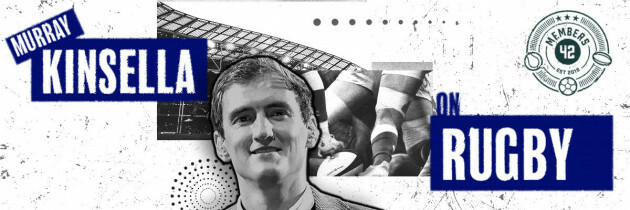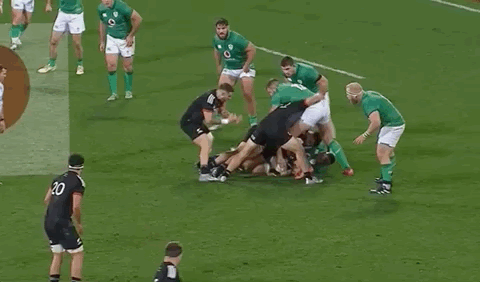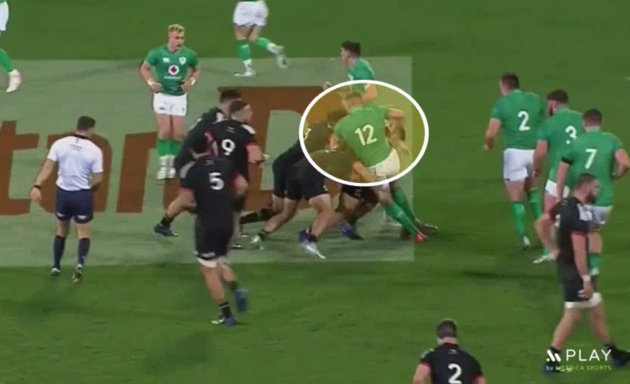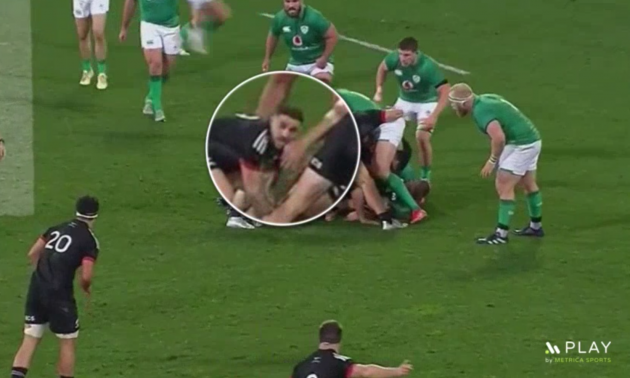To read this exclusive analysis in full and enjoy the many benefits of The42 membership including access to the unmissable Rugby Weekly Extra podcast with Murray Kinsella, Bernard Jackman, Eoin Toolan and Gavan Casey, sign up here.
YOU MIGHT REMEMBER just how incredulous TJ Perenara was when the above happened in Ireland’s midweek win over the Māori All Blacks back in July.
As we’ll see below, he wasn’t the last one to be left flabbergasted by a tactic that has become popular with certain Irish players. England’s Maro Itoje is another who specialises in this area.
It’s debatable whether this play is something that rugby should be allowing to happen and we will be fascinated to hear if it comes up at World Rugby’s meeting with the unions next month for discussions around laws just under a year out from the next World Cup. Lots of people in the game would like to see it outlawed.
As for the instance in New Zealand during the summer, Perenara vehemently appealed to referee Karl Dickson that Stuart McCloskey’s actions were illegal.
“He’s offside. If he’s part of the ruck, he can’t make the tackle, you know that!” appealed Perenara, but Dickson pointed out that McCloskey “played your arm, not the ball, which he’s allowed to do” and Ireland back row Nick Timoney politely told Perenara, “There’s no ruck when you pick up the ball.”
It’s one that Perenara struggled to accept. He has 78 Test caps for the All Blacks and is no doubt a real student of the game. He has been around the block, and he simply couldn’t see it as anything other than illegal play by McCloskey.
To be fair to Perenara, it does look wrong on first glance but McCloskey, as per how referees are adjudicating this at the top level, got this right as he forced a turnover.
As we see below, McCloskey is initially involved in the tackle.
Characteristically, McCloskey manages to stay up on his feet as the Māori ball-carrier goes to ground and with Kiwi centre Alex Nankivell bound onto him, McCloskey now becomes part of the ruck.
Nankivell doesn’t drive McCloskey away beyond the ball, with the Irish centre showing some fight to stay where he is – up on his feet and now leaning his left arm over towards Perenara.
In the moment above, the ball is still in the ruck because Perenara hasn’t yet lifted it off the ground.
McCloskey shows patience and a fair degree of balance to wait for Perenara to actually lift the ball – meaning the ruck has ended.
Only when Perenara lifts the ball does McCloskey reach out to grab Perenara’s arm.
It’s important that McCloskey is on his feet. If he was off his feet in the ruck, he would not be entitled to make this play on Perenara. World Rugby’s Law Book states that “the game is played only by players who are on their feet.”
Perenara’s argument that McCloskey is “offside” does makes sense in one way. Clearly, McCloskey is ahead of the offside line here. But remember, he is only ahead of that line because he’s part of the ruck.
When Perenara lifts the ball, the ruck has legally ended and, therefore, we’re suddenly in open play. With no ruck, there’s no offside line. McCloskey isn’t retreating from an offside position either, since he was part of the ruck. So he can tackle Perenara, as he does here.
The Law Book doesn’t seem to specify that players on their feet in the ruck can’t play the ball itself – we know that they can in other tackle situations – but that’s how referees adjudicate these specific instances. Dickson reminds us of that fact when Perenara complains.
The English referee backs McCloskey’s actions in this example and clearly, the Ulster centre has been encouraged to continue with this tactic.
Below, we see him in action against the Lions two weekends ago in the URC.
To read the rest of this analysis and enjoy the many benefits of membership, sign up here.
Originally published at 10.05; Updated at 17.05







